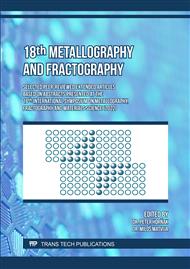p.156
p.165
p.171
p.177
p.183
p.189
p.195
p.201
p.209
Characterisation of a San Mai Steel Composite for the Manufacture of Knives
Abstract:
The term San Mai is used for the manufacture of knife blades consisting of three layered steel composites. The middle layer, which forms the cutting edge, consists of hard steel and on the outside a soft stainless steel is forged. Mr. Benjamin Kamon, an Austrian blacksmith, provided the examined sample. Three different steels and a thin Ni layer are symmetrically connected (1.4301/1.3520/Ni/1.2519/Ni/1.3520/1.4301). The middle layer is a cold work steel (1.2519) and the Ni layer is to prevent diffusion processes. 1.3520 is a heat treatable steel for rolling bearings, followed by an austenitic stainless steel (1.4301). Metallography and SEM-EDX were used to study the microstructure, the interfaces between the different steels as well as diffusion zones. It can be stated that all layers are well connected and no defects are evident.
Info:
Periodical:
Pages:
183-188
Citation:
Online since:
March 2023
Authors:
Keywords:
Permissions:
Share:
Citation:



